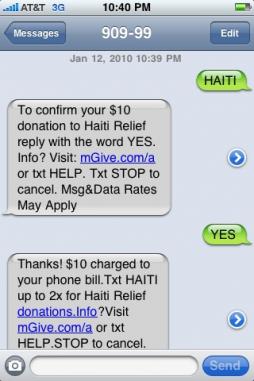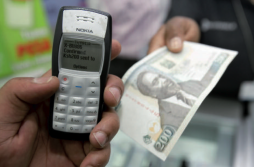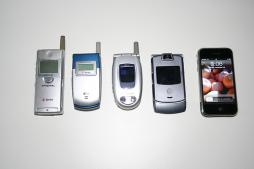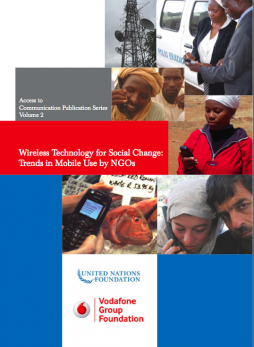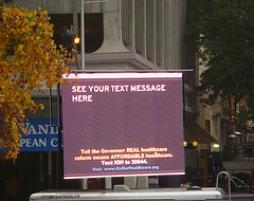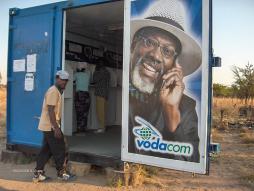mobile advocacy
Posted by KatrinVerclas on Jan 14, 2007
Amnesty's campaign to close Guatanamo using SMS has been bothering me ever since I opted in to the mobile action network. Don't get me wrong - the web campaign is great and the pictures and stories on the blog are effective.
But the mobile campaign is all wrong. Yes, mobile campaigns are a new medium, only beginning to show a return, and not well understood. This is even true for big commercial campaigns that are only now sticking their toes into the mobile marketing waters.
But come on, advocacy organization, you are smarter than that. Mobile marketing is not rocket science, there is already a lot we know, and even as you experiment, use some common sense and pay attention to what you already know about engaging users and constituents.
So in order:
1. What's happening in the mobile marketing market that advocacy organizations should pay attention to (caution: this is US-centric!)
- Carriers in the US are loosening up their previously tight restrictions on mobile advertising. Verizon, Sprint/Nextel, and AT&T are now allowing banner ads on their landing pages
- More and more Americans have WAP-enabled phones, allowing them to do more and more on their cell phones, including watching video and photos, browsing the web, and of course, ubiquitous text messaging. rich media mobile messaging for greater brand and communication impact. Marketers now have at their disposal MMS (define), WAP push (clickable links to WAP-based multimedia content incorporated into SMS messages), and video shortcodes (consumers receive a video stream directly to their handset in response to texting to a shortcode).
- Altogether more than 74% of US adults have cell phones -- and they do not leave the house without them (and their keys and wallets - the three things most adults walk around with at all times.)
- Sms/texting is growing by leaps and bounds with more than 64.8 billion SMS messages sent in the first six months of 2006, up 98.8% from 32.6 billion in first six months of 2005.
- Mobile marketers are salivating, with polls, contests, coupons, and even mobi-sodes, short sms serial stories hitting the commercial market. Pepsi, Ford, Toyota, Burger King all have mobile campaigns, and more and more marketers are allocating hard dollars to "mobile marketing" budgets.
- Visa announced its mobile payment platform, allowing cardholders to use their mobile phones to make purchases or conduct other transactions by tapping them against readers. Think 'just in time' fundraising.
But what's the ROI for mobile marketers - such as advocacy organizations?
Everyone agrees, the medium is young, it is risky when poorly done, and it'll take time to judge payoffs. MobileActive's research of existing campaigns shows some interesting returns with sizeable opt-ins, and rather impressive open and forward rates for campaigns conducted by IFAW and Oxfam, for example. We will be publishing more details from specific campaigns in the next MobileActive Guide on Mobile Advocacy.
While a lot of metrics are still elusive, Brandweek reports about a commercial campaign: For the "Everydayrocks" text initiative, some 13,000 people opted in. And more than 75% of the entrants responded to SMS messages from the brand and/or redeemed mobile coupons. Only 4.8% opted out. Most telling, however, was that mobile emerged as the conduit with the best market reach; mobile outperformed radio by more than 64% and billboards by 24%. Overall, the mobile redemption rate was 28%, making it by far the most effective component."
We have seen positive other PR as well - a clever campaign, especially one that goes viral, will get earned media coverage and word-of-mouth exposure
What are advocacy organizations concerned about?
According to Brandweek, there still is considerable "consumer resistance, the main reason behind the carriers' historic refusal to open the gates to ad content." Brandweek goes on: "Studies have shown that consumers are less than thrilled with the idea of receiving ads on their cells. While early adopter teens are among the biggest targets, three-quarters of cell phone users ages 10 to 18 said they do not think it's OK to be marketed to on a mobile device, according to a study of 2,000 users conducted by Weekly Reader Research, Stamford, Conn., on Brandweek's behalf. Forrester Research in Cambridge, Mass., found 79% of consumers are turned off by the idea of ads on their phones and a mere 3% of respondents said they trust text ads."
There are now strict guidelines, drafted by the Mobile Marketing Association, on opt-in and opt out procedures.
It's my phone! Be scrupulous about your opt-in practices, absolutely meticulous in following the mobile marketing code of ethics, and make your vendors follow them to the T. Your brand is at stake, and people will get very annoyed if they perceive you spamming them.
But this is not stopping mobile marketers who are chomping at the bit.
So, what do we know about effective mobile marketing?
Can we talk?
1. Mobile messaging should be about interaction, do not just pitch. A hard notion for advocacy organizations used to pushing email messages by the millions. Mobiles offer a unique opportunity for interaction. Advocacy organizations need to think about mobile marketing as a conversation, a way to interact two-ways with their constituents.
2. Trust is key here as the mobile medium is so very personal. Gain permission and offer relevant and timely content.
3. Pull people to mobile interaction through other media -- ads, billboards, the web and offer, in turn, mobile interaction with those media.
4. Be careful about targeting your demographics and make your ask accordingly -- asking an older constituency to upload mobile photos is probably not going to be very successful.
5. Be relevant. Offer timely news and functional updates that are of interest to your audience-- and be clever. Just by way of an idea: The American Lung Association could offer air quality updates via sms for where I live, for example. In Amnesty's case, I would like to know how many others are signing the petition and how it's going -- what are others saying and how successful is the campaign? Send me an sms with an update since signing on -- I have not heard a lick from Amnesty since I signed the petition two days ago.
6. Mobile marketing works best when it's pull, not push, and there is an opportunity for people to express themselves - to 'talk' back, to suggest, to respond. Humor works here!
7. Be multi-media. Integrate your mobile marketing and messaging into your entire media and messaging campaing; do not let mobile be an add-on - it shows, and it costs you if not done well.
This is a world that is rapidly evolving. Bandwith and technology improving al the time, we will see Internet- and TV-style ads, search, and much more branded content.
For advocacy organizations, mobile marketing is used most effectively for facilitating a dialogue with their constituents. This 'third screen' can create extended conversation, creating connections across online and traditional media exposures.
So what should Amnesty have done better here?
1. Do no ask me for my email to sign the petition, let me do it via sms.
2. Show what people are saying on the petition via sms, in real time on the blog, in ads, in public interest announcements -- in your other media campaign.
3. Tell me back how it is going -- what other people are saying, what is happening.
4. Communicate regularly with me VIA text, BUT remind me of how to opt out.
5. Ask me to forward a note, ask me to make a call, ask me to express myself in a some way in a poll, in a 160 character message, poem or statement.
6. Use humour, allow for humour -- it may be gallows humour in the case of Gitmo, but hey...
Overall: engage me, and do not let me feel that I am sinking in your typical advocacy 'push' hole that benefits you organizationally, but in the end has no impact on the issue, nor engages me in any way.
In the end, because mobiles are so personal, there is a huge opportunity for a conversation that few advocacy organizations used to messaging OUT have any idea how to do effectively. Mobiles are very much a read/write medium in the web 2.0 fashion and only those organizations willing to hear back and engage in 'it's the conversation, stupid' will end up running catchy, creative, engaging, and innovative mobile campaigns.
Posted by AnneryanHeatwole on Sep 29, 2010
MobileActive.org turns five this fall. We think that this is a perfect time to highlight the creative and amazing practitioners in the m-4-change field. Our community of developers, organizers, advocates, field staff, researchers, donors, and many more is what makes this peer network so strong and vibrant.
We wanted to hear from you on where the field of 'mobiles for change' has been, where it's going, and how a community like MobileActive.org can help along the way. So we called people around the world who have been in the field for a while to hear their thoughts.
Marty Kearns (Green Media Toolshed), Brenda Burrell (Kubatana), Bukeni Waruzi (Witness.org), Chris Spence (National Democratic Institute), Karen Doyle Grossman (Mercy Corps), and Ben Rigby (The Extraordinaries) shared their thoughts on three questions:
Posted by AnneryanHeatwole on Feb 19, 2010
We are releasing today the first-ever Nonprofit Text Messaging Benchmark Study (PDF) The study, sponsored by Mobile Commons and mGive, takes a look at how organizations in the United States are using text messaging and how subscribers are responding. It reveals that mobile phones are becoming increasingly popular for advocacy with organizations.
Written by Michael Amoruso and Jessica Bosanko of M+R Strategic Services and Katrin Verclas of MobileActive.org, the report “provides benchmarks and metrics by which nonprofit organizations can measure their success with text messaging and illustrate the various ways in which organizations are using text messages.”
The earthquakes in Haiti earlier this year showed that SMS can be a powerful tool for fundraising (raising millions in just a few days); it’s clear that the time is ripe for non-profits to tap into the mobile market in order to engage their supporters. According to the Mobile Benchmark study (PDF), there are currently over 276 million wireless users in the U.S. and during the first half of 2009, users sent about 740 billion text messages. The report breaks down not only how non-profits can use SMS to interact with supporters, but also releases statistics on how specific organizations fared with their SMS campaigns.
| Mobile Benchmarks 2010: How Are Non-Profits Using Text Messaging? data sheet 7794 Views |
| Countries: |
United States
|
Posted by KatrinVerclas on Aug 13, 2008
Below are some awards and funding opportunities that we have come across that might be of interest to the MobileActive community. None of the opportunities listed are adinistered by MobileActive; we are just the messenger!
Women in Science Competition
Recognising women scientists in sub-Saharan Africa who are "engaged in innovative and pioneering research and communicating the outputs - knowledge, technologies, approaches - for enhancing agricultural performance in sub-Saharan Africa." This competition is also designed for women scientists who are repackaging and communicating existing knowledge to improve the agricultural productivity and livelihoods of rural communities, or who are advocating for policy change to optimise the benefits of scientific and technological developments. Deadline: August 15 2008, more information here.
Posted by KatrinVerclas on Jul 15, 2008
By Bruce Girard, reposted with permission.
At first glance SMS text messages would seem like a natural for inclusion in a community radio station’s essential toolkit. SMS messages are inexpensive and easy-to-use and in recent years the mobile phones that are needed for sending and receiving them have become ubiquitous. However, an informal survey of recent projects indicates that use of SMS messages among community media in the developing world is still at an early stage. In most stations SMS use is informal. The few cases identified of community stations making more complex use of SMS messages have accompanied political crises or natural disasters and have inevitably been donor financed. There are few, if any, experiences of complex uses of SMS by community media without external funding and technical support, even though the financial and technical resources required are minimal.
Posted by CorinneRamey on Jun 27, 2008
Note: This primer was written for the NTEN newsletter, targeted at a US audience and thus focuses on America. For more on mobile advocacy in many other parts of the world, see here.
Posted by CorinneRamey on Jun 25, 2008
Note: This primer was written for the NTEN newsletter, targeted at a US audience and thus focuses on America. For more on mobile advocacy in many other parts of the world, see here.
Mobile phones are more prevalent in the U.S. than ever before. Today, over 86% of the US population ages 13 and up owns a mobile phone. Although Americans say that the mobile phone is the device that they hate the most (it even beats the alarm clock and the television!), the cell phone is here to stay. In the past decade, mobile users have grown from about 34 million to more than 203 million, and growth is expected to continue to increase exponentially.
Posted by CorinneRamey on May 13, 2008
Mobile phones are nothing new for Greenpeace Argentina. The organization has used mobile phones multiple times to mobilize its now 350,000 person-strong mobile list to successfully lobby for important environmental legislation. One of Greenpeace's significant accomplishments was the passage of the Ley de Bosques, or Forest Law.
According to a recently UN/Vodaphone report, Wireless Technology for Social Change: Trends in NGO Mobile Use, before the law was passed forests in Argentina were being quickly destroyed. From the report:
Every hour, trees covering an area the size of forty soccer fields are cleared from the old growth forests of Argentina, home to indigenous tribes and numerous endangered species. According to Greenpeace, 300,000 hectares (3,000 square kilometers or 1,150 square miles) of native forest are cleared in Argentina each year.
Posted by KatrinVerclas on Apr 29, 2008
Mobile technology is transforming the way advocacy, development and relief organizations accomplish their institutional missions. This is nothing new to readers of MobileActive. Our recent report Wireless Technology for Social Change: Trends in NGO Mobile Use, released today by the United Nations Foundation and The Vodafone Group Foundation, brings this point home.
Wireless Technology for Social Change: Trends in NGO Mobile Use was written by Sheila Kinkade (ShareIdeas.org) and Katrin Verclas (MobileActive.org), and commissioned by the United Nations Foundation-Vodafone Group Foundation Technology Partnership. The report examines emerging trends in “mobile activism” by looking at 11 case studies of groups active in the areas of public health, humanitarian assistance and environmental conservation.
Posted by KatrinVerclas on Apr 24, 2008
Mobile advocacy efforts are just beginning around the world. What are we learning from these emergent campaigns what works and what does not in using mobile phones to advance a cause or an issue?
Of course, we think that advocacy organizations should start to pay serious attention to using mobiles in their work. There is increasing evidence that mobile social marketing works in increasing brand awareness and moving people to actions. It is also becming an increasingly effective way to engage users and constituents. Here are a few pointers from what we have learned to date. (NOTE: This pertains to US-based campaigns).
1. What's happening in the mobile (social) marketing market that advocacy organizations should pay attention to?
Posted by CorinneRamey on Mar 04, 2008
Imagine if every member of the legislature could see a message from your constituents, just by looking out of the window. A text-to-screen campaign allows for exactly this: A large screen, placed right outside the State House, for example, that brings your constituents’ text messages to legislators' eyes.
Not only can people in front of the screen see the message, but anybody can watch a live feed of the messages on a website. "Text to screen allows people in remote locations to interact in a meaningful way with one location," says Jed Alpert of Mobile Commons, a vendor providing a text-to-screen platform.
Individuals interact with the screen by sending a text message or SMS to a short code (a five or six-digit phone number). The SMS is then displayed on jumbatron screen, as well as on a web screen.
Posted by CorinneRamey on Jan 22, 2008
Ever wondered how Walmart ranks when it comes to supporting gay and lesbian employment equality? What about Starbucks, Coca-Cola, or Microsoft? Employment equality is an issue that the gay and lesbian community has advocated for for years. It has now moved into the cellphone age with point-of-purchase company information for conscious consumers. The U.S.-based Human Rights Campaign recently launched a new tool: An SMS buyers guide that that brings instant information about businesses' support of gay and lesbian equality straight to your mobile phone.
Posted by KatrinVerclas on Sep 27, 2007
In a quick move, the US carrier Verizon today reversed its refusal to issue a short code to abortion rights advocacy organization NARAL. According to a statement by Verizon:
"The decision to not allow text messaging on an important, though sensitive, public policy issue was incorrect, and we have fixed the process that led to this isolated incident. Upon learning about this situation, senior Verizon Wireless executives immediately reviewed the decision and determined it was an incorrect interpretation of a dusty internal policy. That policy, developed before text messaging protections such as spam filters adequately protected customers from unwanted messages, was designed to ward against communications such as anonymous hate messaging and adult materials sent to children.
"Verizon Wireless is proud to provide services such as text messaging, which are being harnessed by organizations and individuals communicating their diverse opinions about issues and topics. We have
great respect for this free flow of ideas and will continue to protect the ability to communicate broadly through our messaging service."
Posted by KatrinVerclas on May 09, 2007
Ethan Zuckerman has written a solid overview of mobile phones in international activism. It is re-posted here under its Creative Commons license. For additional resources, see also the mobileactive.org Strategy Guides on using mobile phones in elections, advoacy, and fundraising.

